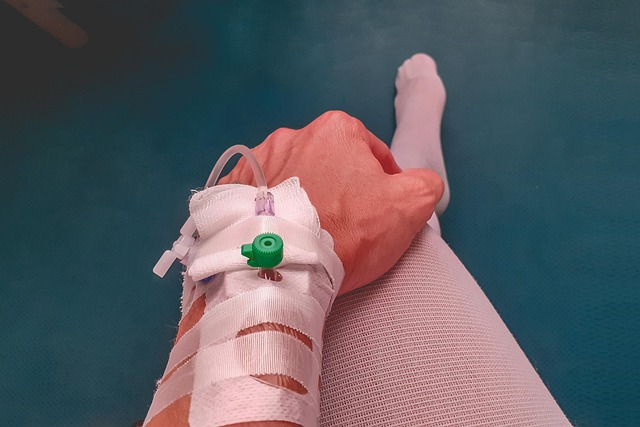Behavioral therapy, including Cognitive Behavioral Therapy (CBT) and exposure therapy, is an evidence-based approach for treating anxiety disorders by targeting negative thought patterns and behaviors. This method aims to provide long-term solutions through techniques like challenging irrational thoughts, relaxation strategies, and gradual exposure to fears. A healthy lifestyle routine, combined with structured therapy sessions and regular practice outside of them, enhances the effectiveness of CBT for anxiety management. Tracking progress through assessments and adopting proactive relapse prevention strategies further ensure successful outcomes in anxiety treatment.
Anxiety can significantly impact daily life, but behavioral therapy offers a powerful tool for managing it. Cognitive Behavioral Therapy (CBT) is a form of behavioral therapy that focuses on identifying and changing negative thought patterns and behaviors contributing to anxiety. This article explores various CBT techniques, from challenging negative thoughts and exposure therapy to relaxation strategies and lifestyle changes. We’ll guide you through the therapist selection process, progress tracking, and long-term management tips for effective anxiety treatment.
Understanding Behavioral Therapy for Anxiety Disorders

Behavioral therapy for anxiety disorders focuses on identifying and changing harmful thought patterns and behaviors that contribute to anxiety. This type of therapy is evidence-based, meaning it has been scientifically proven to be effective in treating various anxiety conditions, such as generalized anxiety disorder, panic disorder, and social phobia. The goal is to help individuals manage their symptoms by learning coping strategies and gaining a better understanding of the connection between thoughts, feelings, and behaviors.
Through structured sessions, therapists guide clients to challenge negative thought processes, face fears in a safe environment, and develop healthier responses. Techniques like exposure therapy and cognitive behavioral therapy (CBT) are commonly used. Exposure therapy gradually exposes individuals to anxiety-provoking situations, helping them realize that their feared outcomes rarely occur. CBT teaches practical skills to identify and reframe distorted thoughts, reduce avoidance behaviors, and improve overall well-being. By addressing underlying causes and equipping individuals with effective tools, behavioral therapy offers a long-term solution for managing and overcoming anxiety.
Common Techniques in CBT for Managing Anxiety

Cognitive Behavioral Therapy (CBT) is a widely recognized and effective anxiety treatment approach. It focuses on identifying and modifying negative thought patterns and behaviors that contribute to anxiety. Common techniques in CBT for managing anxiety include:
1. Identifying cognitive distortions: Therapists help individuals recognize and challenge irrational thoughts and beliefs that trigger anxiety. By questioning these distorted thoughts, patients learn to replace them with more realistic and balanced perspectives, reducing the intensity of their anxious responses.
2. Exposure therapy: This technique gradually exposes individuals to situations or objects they fear, allowing them to confront and overcome their anxiety in a safe environment. Through repeated exposure, individuals develop coping strategies and realize that their feared outcomes are unlikely to occur, leading to reduced anxiety over time.
Identifying and Challenging Negative Thoughts

Negative thoughts are a significant contributor to anxiety, often creating a cycle of worry and fear. Identifying these thoughts is the first step in behavioral therapy for anxiety treatment. Once recognized, individuals can begin to challenge their validity and rationality. Many negative thoughts are exaggerated or distorted, leading to inaccurate beliefs about potential outcomes.
Through therapy, individuals learn to question and reframe these thoughts. For example, instead of thinking “I’ll fail this test,” a person might reflect on past successes and consider the likelihood of doing well, replacing the anxious thought with a more realistic and positive one. This process empowers individuals to manage their anxiety by changing their thought patterns and thus reducing the intensity of emotional responses.
Exposure Therapy: Facing Fears Gradually

Exposure therapy is a powerful technique within behavioral therapy for anxiety, focusing on gradually confronting fears in a safe and controlled environment. This approach aims to help individuals face their anxieties head-on, reducing the impact of worry and fear over time. By slowly exposing themselves to feared situations or objects, people can learn to manage their reactions and realize that their worst-case scenarios rarely come to pass.
The process begins with identifying specific fears and ranking them based on severity. Therapy then involves creating a hierarchy of these triggers, starting from the least anxious-inducing situation, gradually working up to more challenging scenarios. This hierarchical approach allows for steady progress, ensuring individuals feel empowered as they overcome each step successfully. With consistent practice and guidance, exposure therapy equips people with coping strategies to confront anxiety-provoking situations in their daily lives, offering an effective anxiety treatment method.
Relaxation Strategies within Cognitive Behavioral Therapy

Relaxation strategies play a vital role in Cognitive Behavioral Therapy (CBT) as an anxiety treatment approach. These techniques are designed to help individuals manage and reduce their anxiety symptoms by teaching them to control their physical and mental responses during stressful situations. CBT incorporates various relaxation methods, such as deep breathing exercises, progressive muscle relaxation, and mindfulness meditation, which empower patients to calm their minds and bodies.
By regularly practicing these strategies, individuals can learn to recognize and challenge negative thought patterns associated with anxiety. This process enables them to replace anxious thoughts with more rational ones, fostering a sense of control over their emotional reactions. As a result, relaxation techniques within CBT offer long-lasting benefits for anxiety treatment, promoting better coping mechanisms and improved overall well-being.
Lifestyle Changes to Support Anxiety Treatment

In conjunction with therapy sessions, making certain lifestyle changes can greatly enhance anxiety treatment. One key aspect is adopting a healthy routine, encompassing regular exercise, balanced nutrition, and adequate sleep. These foundational elements play a pivotal role in stabilizing mood and reducing stress levels. Additionally, incorporating relaxation techniques such as deep breathing exercises, meditation, or yoga into daily life can help individuals manage their anxiety symptoms more effectively.
Further support comes from cultivating strong social connections and engaging in activities that foster a sense of well-being. Spending time with loved ones, participating in hobbies, or exploring nature can provide much-needed breaks from anxious thoughts. By seamlessly integrating these lifestyle adjustments into their lives, individuals undergoing anxiety treatment can gain greater control over their symptoms and improve their overall quality of life.
Working with a Therapist: Expectations and Process

Working with a therapist for anxiety treatment involves setting clear expectations and understanding the process. Initially, therapists will assess your symptoms, triggers, and personal history to tailor a unique treatment plan. This often includes techniques like cognitive behavioral therapy (CBT), mindfulness practices, and relaxation strategies. The goal is not only to manage symptoms but also to equip you with tools to cope effectively in everyday life.
During sessions, therapists create a safe, non-judgmental space for you to explore and express your feelings. Through open dialogue and structured exercises, you’ll learn to identify and challenge negative thought patterns contributing to your anxiety. Regular practice of acquired techniques outside therapy sessions is crucial for progress. Over time, as you gain insights and develop coping mechanisms, your therapist will help you gradually face fears, reducing anxiety’s hold on your life.
Tracking Progress: Measuring Success in CBT

Tracking progress is a vital aspect of Cognitive Behavioral Therapy (CBT) for anxiety treatment. Therapists often use structured assessments and standardized measures to evaluate a client’s symptoms at the beginning of therapy, known as baseline measurements. This provides a clear starting point and allows for the monitoring of changes over time. By regularly assessing anxiety levels, therapists can identify areas of improvement and make necessary adjustments to the treatment plan.
Measures such as the Generalized Anxiety Disorder 7-Item Scale (GAD-7) or the Panic Disorder Symptom Scale (PDSS) help quantify symptoms, providing tangible evidence of progress. These tools enable therapists to communicate effectively with clients about their improvements, fostering motivation and a sense of accomplishment. Regular tracking also helps in recognizing patterns and triggers associated with anxiety, leading to more personalized and effective CBT interventions.
Long-Term Management and Relapse Prevention

Long-term management of anxiety involves strategies to prevent relapse and maintain progress made during therapy. This often includes learning techniques to recognize and manage triggers, as well as adopting healthier coping mechanisms. Cognitive behavioral therapy (CBT) emphasizes identifying negative thought patterns and replacing them with more realistic, positive thoughts. Regular practice of these skills is key to preventing relapse; individuals may need ongoing support through check-ins with therapists or participation in support groups.
Relapse prevention focuses on preparing individuals to handle future challenges. It involves setting personal goals, understanding potential setbacks, and creating action plans for managing anxiety symptoms. By staying proactive and committed to their treatment plan, those undergoing anxiety treatment can reduce the likelihood of relapsing and maintain lasting improvements in their mental health.
